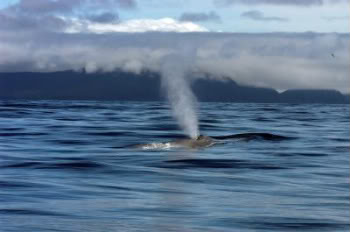|
|
The blue whale may be returning to a migration route that it abandoned during commercial whaling. Researchers have discovered whales migrating from California to the coastlines of British Columbia and the Gulf of Alaska for the first time since 1965. Fifteen different cases of whales have been recorded in the north Pacific; four of the whales were individuals who had been viewed off the coast of California, as well.
Researchers from Cascadia Research Collective in Washington, NOAA’s Southwest Fisheries Science Center in California, and Canada’s Department of Fisheries and Oceans used the blue whale’s distinctive pigmentation patterns of their skin color and the shape of the dorsal fin to positively match the individuals seen in the north Pacific with those off of California.
 A blue whale spouts off Moresby Island, British Columbia. Photo by: John Calambokidis, Cascadia Research Collective. |
Questions remain as to why the whales have begun migrating back of the north Pacific. One theory is that changing conditions in the ocean has caused the whales’ food source, krill, to move north. Climate change could be behind the move: a warming ocean may be causing a massive krill migration. Another possibility is that there are simply too many whales feeding near California, so some have begun changing their route.
Twentieth Century whaling decimated populations of blue whales in the north Pacific as far south as Baja California. The whales in southern California rebounded successfully after hunting was banned, while the population in the north Pacific has never recovered.
The historic population of blue whales, prior to commercial hunting, has been estimated at 200,000. Today there are anywhere from 5,000-12,000 blue whales in the world, 2,000 of which inhabit the Western coast of the US. The blue whale is listed as endangered by the IUCN Red List.
Related articles
Marine Protected Areas too small for whales and dolphins
(04/07/2009) Current Marine Protected Areas (MPAs) are too small to adequately serve whales and dolphins according to the Whale and Dolphin Conservation Society (WDCS). The international organization is calling for a global network of MPAs to save the ocean’s most beloved inhabitants. “A worldwide effort must be made urgently to identify and define whale and dolphin critical habitats and hot spots,” said WDCS Research Fellow, Erich Hoyt.
Infant blue whale filmed underwater
(03/06/2009) Off the waters of Costa Rica in January 2008 scientists and photographers with National Geographic filmed an infant blue whale swimming near its mother. They believe this is the first time a baby blue whale has been filmed underwater.
The end of migrations: wildlife’s greatest spectacle is critically endangered
(07/28/2008) If we could turn back the clock about 200 years, one could watch as millions of whales swam along their migration routes. Around 150 years ago, one could witness bison filling the vast America prairie or a billion passenger pigeons blotting out the sky for days. Only a few decades back and a million saiga antelope could be seen crossing the plains of Asia.